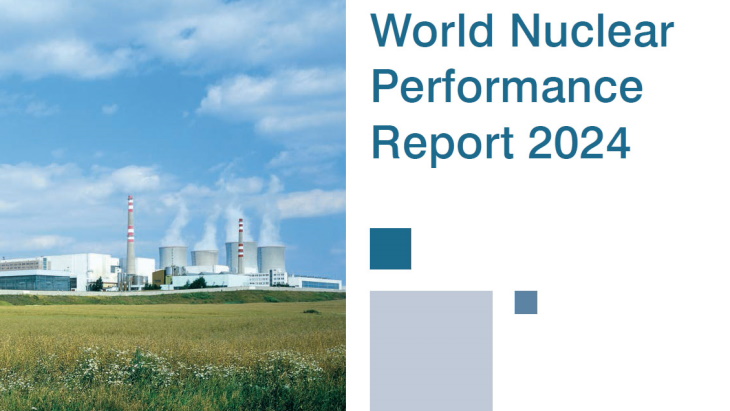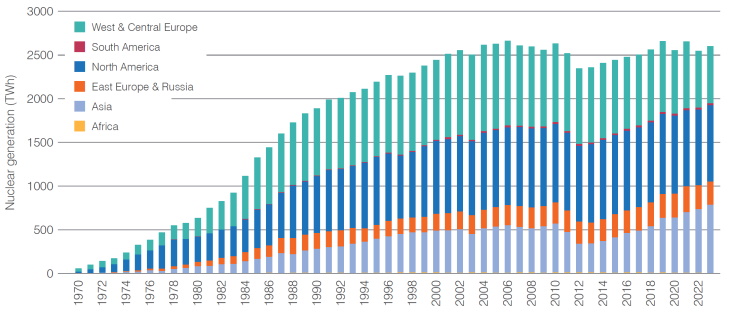
The latest annual World Nuclear Performance Report - the ninth in the series - says nuclear generation supplied more than 2600 TWh last year, up 58 TWh from 2022, and accounted for 9% of the world's electricity production. This increase was partly due to the return to service of French reactors after extended outages, contributing an additional 42 TWh.
The average capacity factor of nuclear reactors increased by 1%, reaching 81.5% in 2023, "highlighting the reliability delivered by nuclear energy to the grid", the report notes. Nuclear reactors have consistently achieved more than 80% capacity factors for the past 20 years. Reactor performance remains high regardless of age.
"The increase in generation, despite a drop in capacity, highlights the excellent performance and value delivered by nuclear energy to the grid," World Nuclear Association said.

Global nuclear electricity production (Image: World Nuclear Association)
Nuclear reactors helped avoid 2.1 billion tonnes of carbon dioxide emissions in 2023 from equivalent coal generation - "that's more than the annual emissions of almost every individual country, with only China, India, and the USA having higher national CO2 emissions", the report notes.
There were 437 reactors in operation at the end of 2023 - the same as at the end of 2022 - with five reactors shutting down (Belgium's Tihange 2, Taiwan's Kuosheng 2 and Germany's Emsland, Isar 2 and Neckarwestheim 2) and five being connected to the grid (China's Fangchenggang 3, Slovakia's Mochovce 3, USA's Vogtle 3, Belarus's Ostrovets 2 and South Korea's Shin-Hanul 2) during the year.
Six new construction projects started in 2023, five of which were in China (Sanmen 4, Haiyang 4, Lufeng 6, Lianjiang 1 and Xudabao 1) and the other in Egypt (El Dabaa 3). Of the total 64 reactors currently under construction, more than two-thirds are in Asia, with 30 reactors under construction in China alone. Eastern Europe and Russia are second to Asia in terms of the number of units under construction.
At the COP28 climate change conference in Dubai in December 2023, nuclear energy received high-level recognition for the first time. Leaders from 25 governments signed a ministerial declaration committing to the tripling of global nuclear energy capacity to achieve net-zero by 2050.
"The World Nuclear Performance Report 2023 data and case studies illustrate the work being done to improve operational performance and make the most of the current nuclear fleet," said World Nuclear Association Director General Sama Bilbao y León.
"At the same time, a significant increase in new nuclear construction is necessary if the tripling goal is to be achieved. This level of construction depends on the nuclear industry rising above the financing, supply chain and regulatory challenges faced by new projects, particularly in the Western world."
She added: "The global nuclear reactor fleet has a proven track record of excellent performance. It is now time to build on that track record and significantly accelerate the pace of new nuclear construction.
"The industry is set for a major expansion, and we can expect more governments and companies to sign the declaration to triple global nuclear energy capacity. Additionally, we anticipate increased collaboration with other industries. Now is the time for the nuclear industry to capitalise on this momentum and deliver the full potential of nuclear energy for people and planet."
Mohamed Al Hammadi, Managing Director of Emirates Nuclear Energy Corporation and Chair of World Nuclear Association, said: "The Performance Report is the authoritative stock-take for the performance of over 439 reactors that form the global fleet. With both nuclear energy generation and capacity factor rising in 2023, it is clear that nuclear energy is a proven, reliable and substantial generator of clean electricity for 36 countries today. With many more reactors under development and a further 64 under construction, we look forward to this growth to continue as part of the momentum to triple global nuclear energy capacity by 2050 to not only meet net-zero targets and boost national energy security, but to satisfy the huge wave of demand coming from energy intensive industries such as AI, data centers and electric vehicles.
"Now, further optimising the performance of reactors, extending the safe, reliable, and long-term operation of all units, as well as deploying new units are crucial steps in the re-emergence of civil nuclear energy in the race to net-zero power."
The report features three case studies including: the planned restart of the Palisades nuclear power plant in Michigan, which was shut down in May 2022 after more than 50 years of operation; the planned long-term operation of South Korean reactors; and a power uprate at unit 3 of the Czech Republic's Dukovany plant.